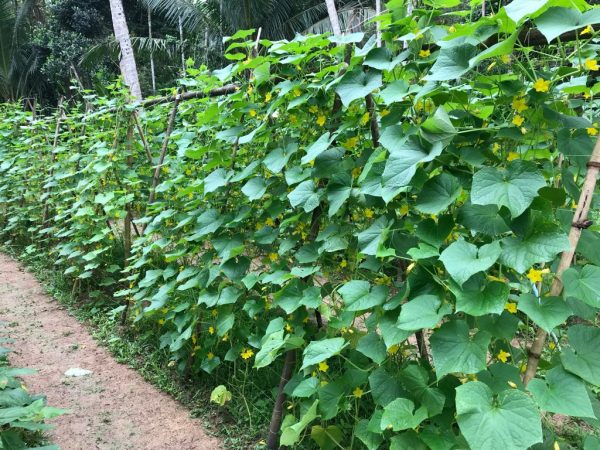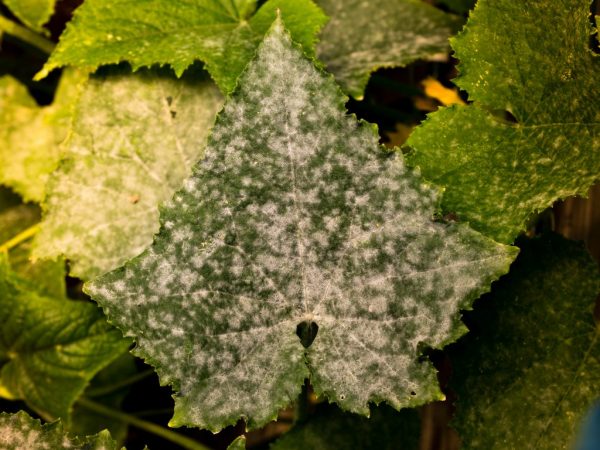The value of sun and shade for cucumbers
Cucumber is a rather whimsical vegetable to grow. For proper development, the plant needs sunlight. It is necessary to choose the right place for planting bushes and control the amount of light that they will receive.

The value of sun and shade for cucumbers
Sun or shade for cucumbers
The sun for cucumbers is needed in moderation. It is quite difficult to choose the right place for planting cucumbers. Cucumber leaves need bright light, while its fruits, on the contrary, like to hide in the shade. To ensure these conditions, it is better to grow the vegetable on a special trellis, since the cucumber branch itself needs support in order to grow correctly.
Too bright sun can burn the leaves and badly affect the fruits, therefore, in the southern regions, it is advisable to plant corn or sunflowers next to cucumbers. They will provide shade that will protect the plant. In the northern regions, where there is a lack of light, it is better to grow cucumbers in a greenhouse. This will provide the vegetable with the right light and support for the branches to develop. If it is not possible to build a greenhouse, you can plant cucumbers in a well-lit area, covering it with a film, and in hot weather, instead of a film, use a non-woven shelter.
Shading grid for cucumber
To cover the cucumber garden from the strong sun, gardeners use a special protective net. It is made of a material that reflects part of the ultraviolet radiation, and a small amount of light is evenly distributed over the garden. It looks like a large canvas with even cuts.
There are several types that differ in the purpose of the appointment:
- Red grid. Improves the amount of harvest, the bushes bloom faster, the fruits grow stronger and larger.
- Gray mesh. Scourges grow faster, more shoots appear.
- Blue-green mesh. Helps protect bushes from excessive solar radiation, provides the right microclimatic conditions, and prevents mold.
The choice of a protective mesh depends on the purpose of use. It is also important to choose the correct shading level. But sun deficiency also badly affects the growth and development of the bushes, the lashes can become thin, and the leaves are small and pale.
Impact of lack of sunlight on cucumbers
If the cucumber receives little sunlight there is a risk of mold on the plant. In such conditions, heat and moisture are good for the growth of fungi, which are toxic and can provoke serious health problems for the vegetable.
Mold on cucumbers
White mold is one of the most common diseases in cucumbers. Because of it, the growth of the vegetable slows down and the disease quickly spreads from infected bushes to healthy ones, which makes it difficult to fight the problem.
Types of mold:
- green - covers the whip completely, and such vegetables should not be eaten;
- white - a bloom of white appears on the stems, the plant dries out;
- black - brown spots appear on the stems, which gradually increase.

Infected plant parts must be removed
At the moment, there is no strain that can completely resist any type of mold. To save the crop, you must first remove all infected plants. And treat healthy seedlings with a special disinfectant solution to prevent the disease.
If mold is noticed in a timely manner and disinfection is carried out, almost the entire crop can be saved.
Slugs on cucumbers
A high percentage of humidity and a lack of sun attracts pests such as slugs to the site. These are small insects that do not have limbs, their body is covered with mucus, the species resembles a snail without a shell.
They live in the ground at a depth of 8 cm. They are active mainly at night. They do great harm, eating both leaves and fruits. They often settle outside the perimeter of the garden, so in order to secure the harvest, you can scatter lime along the border of the garden intended for planting cucumbers.
Hardening of cucumber seedlings
In order for the seedlings to better adapt to external conditions, the cucumbers are hardened in the sun 10-15 days before planting the seedlings in the ground. It is necessary that the plant already has 4-5 true leaves.
Hardening begins at a temperature of 8-10 °, in the shade. At the beginning, the seedlings are taken out into the air for 2 hours, gradually increasing the time. The plant must gradually get used to the sun. The hardening time should be increased daily by about 1.5-2 hours.
Finish hardening before planting seedlings in open ground. During this period, the seedlings should be outdoors all the time, and the disembarkation occurs when they have spent 2-3 nights outside.
Shade cucumber varieties
The area is not always sufficiently illuminated by the sun. And many types of vegetables need enough light. There may be cases when there is not enough space for planting cucumbers, but there are hybrids that grow well in the shade:
- Moscow evenings F1. The fruits of this variety will ripen in 45-50 days, taste good and are suitable for fresh consumption and canning. This species is strongly plaited, blooms mainly with female flowers. Length up to 15 cm, weight about 110g. It resists diseases well.
- The secret of the F1 company. This variety ripens in 40-45 days. The plant is medium branched. It has a cylindrical shape, medium size. It resists powdery mildew and cladosporium well.
- Muromsky 36. This is an early ripening variety that ripens in 35-40 days. Suitable for conservation. The fruits can be either lumpy or smooth. It tolerates temperature drops well. The fruits turn yellow quickly, so it is necessary to collect them in a timely manner.
Conclusion
It is important to remember that both excess and lack of light negatively affect the plant. Due to excessive ultraviolet radiation, the plant can get burned and wither, and its deficiency and moisture contribute to the appearance of pests and the development of diseases. You need to follow the tips above to get a good harvest.


